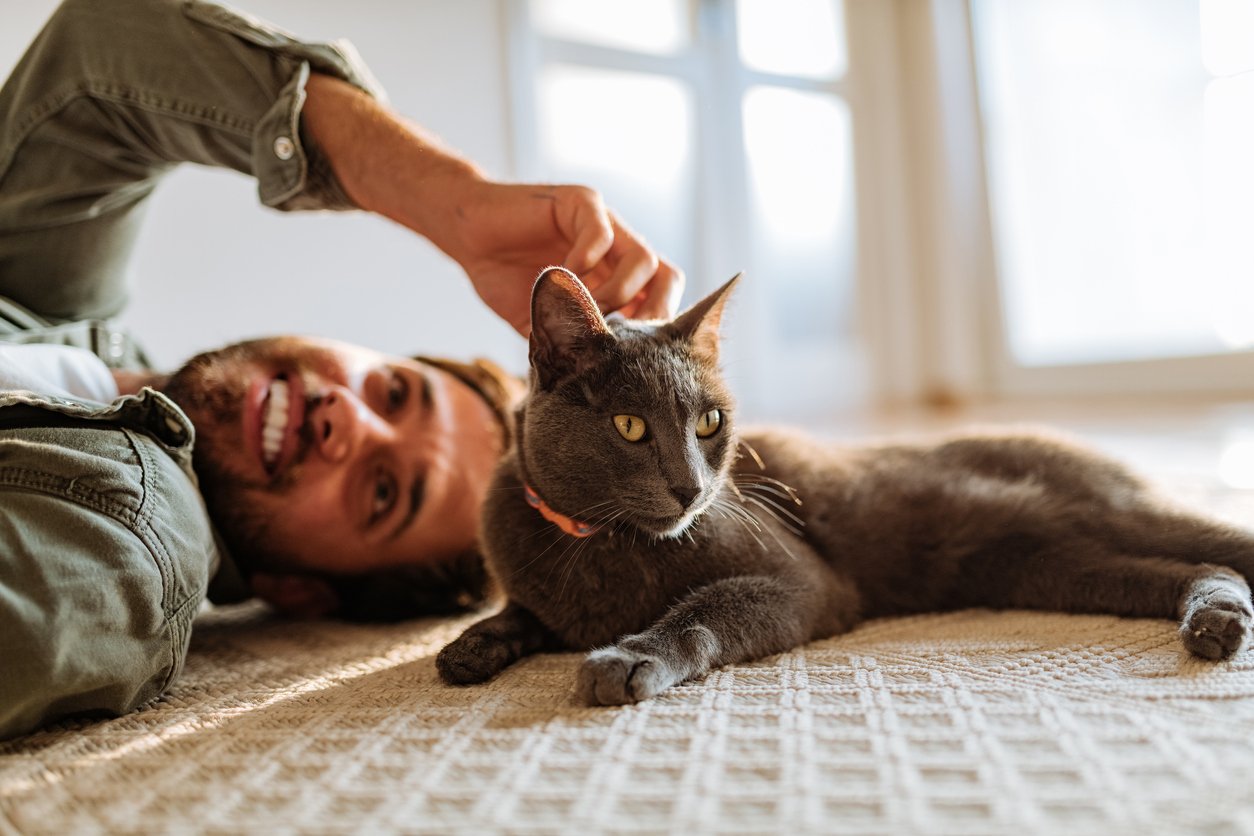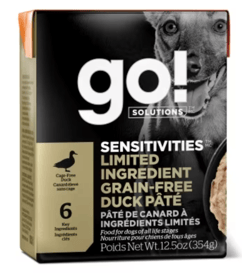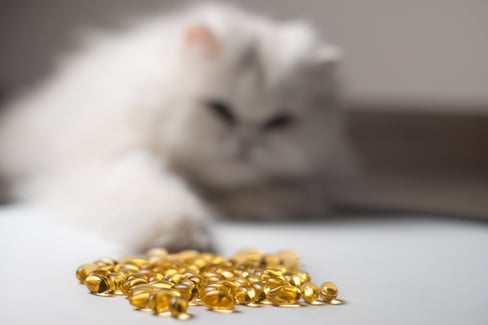Table of Contents
Bringing a new puppy, kitten, or rescued adult or senior cat or dog home for the first time is exciting.
When you get a pet, you not only get a companion, you get a best friend. And keeping your best friend happy and healthy requires knowledge on the best food, treats, and activities you can do with them.
And just like us, sometimes our pets can experience unexpected medical issues—so it’s important to be as prepared as possible for these situations as well.
And besides—educating yourself on the best pet wellness tips and best practices can be fun as you learn more about how to properly care for your new family member.
In this article, we outline what you need to know to keep your good boy or girl happy and healthy in their new home, from when they are a kitten or puppy to an adult. When you understand proper pet wellness care for your furry friend, you can have a much better time hanging out together.
Key Aspects of Pet Wellness Care
Pet wellness is a huge topic consisting of knowledge in nutrition, exercise, grooming, veterinary care, and much more, so it helps to break it down a bit and look at everything from a high level, especially when you’re caring for a pet for the first time.
1. Vaccinations and Vet Checkups
Ensuring your new pet has a regular veterinarian to take them to is important. The vet can get to know your animal over time, which is key for helping them feel more comfortable with vet visits. Having a regular vet also helps with your pet’s care, as the vet will learn about your dog or cat’s unique personality and quirks and be able to use that knowledge to better recognize when something’s amiss.
When you take your dog or cat to the vet for the first time, they can provide you with information about their care, from breed-specific tips and tricks to recommendations on food, supplements, exercise, grooming, and more. Your vet is a fountain of knowledge—so be sure to ask them questions about your new best friend!
2. Pet Food
Would you rather feed your pet McDonald’s or a steak? While we have nothing against the popular fast food restaurant (we love our chicken nuggets), it’s not exactly a secret that eating fast food every day isn’t a healthy choice.
The same goes for our pets. Sure, you can choose the cheapest kibble at the grocery store, and it will keep them fed, but all those fillers, additives, and preservatives probably won’t help them out with staying healthy over time.
And honestly, it isn’t just about the price of the food, it’s about ingredients as well. Regulators like the Association of American Feed Control Officials (AAFCO), The Pet Food Association of Canada (The Pet Food Association of Canada also recognizes the recommendations from AAFCO), and FEDIAF, an association representing the European pet food industry, have put together a list of recommendations that consumers can follow to choose the best food for their pet.
- Nutritional adequacy: Pets at different life stages (puppies or kittens versus adults) need different nutrition. The pet food should clearly indicate the life stage it’s meant for. You should also look for a statement on “nutritional completeness” or “adequacy”, as this is required to tell you whether the food is meant for regular feedings or supplemental only (an occasional treat). If the food says it’s nutritionally complete, that means it must have the correct amount, balance, and availability of nutrients for your pet. Factors like your pet’s life stage, health conditions, allergies, and more should also be considered when choosing a pet food.
- Understand the basics about ingredients: Pet food ingredients can be overwhelming to read. To better understand what’s in your pet’s food, remember that the biggest contributors to the food are listed from most to least in order. So if chicken is the first ingredient on the list, it’s a major ingredient in the food. Sometimes pet food ingredients will say “meat” or meat byproducts” on the label; “meat” means flesh and may contain fat or other tissues like sinew and gristle. “Meat byproducts” means parts like organs, fatty tissues, and bones, but not hair, horns, teeth, and hooves. The same goes for poultry and poultry byproducts, but when the food lists poultry, it may contain bones, and poultry byproducts can mean heads, feet, and internal organs. There are also meals and by-product meal, which essentially goes further down the line in terms of quality parts; meals can be the blood, hair, hoof, horns, hide, etc., and byproduct meal goes even further by potentially including stomach contents, feathers, and even manure.
- Know what nutrients your pet needs: Dogs need a careful balance of calcium, phosphorus, and vitamin D for healthy teeth and strong bones. Large dogs also need an adequate amount of fats and oils. Cats need taurine (which is a vitamin) and also need to limit their intake of Vitamin A. Cats also need twice as much protein as dogs. FEDIAF has a great high-level summary of dog and cat nutrients to refer to.
3. Supplements
Giving your dog or cat supplements can also be an important part of their everyday diet. Joint supplements, fish oil for cats, and digestive enzymes are just a few examples of supplements that you can give your pet.
Knowing how to read a supplement label is the first step in being able to choose an effective pet health supplement. The second is choosing a pet wellness supplement with 100% active ingredients with no fillers, preservatives, or additives, as these ingredients can potentially cause digestive issues for your pet.
- contains 100% active, therapeutic ingredients
- Is easy to administer (simply use the provided scoop to sprinkle the supplement on your pet’s regular food)
- Can be fed to both cats and dogs, in varying amounts, based on weight
TRI-ACTA for Pets
A proactive approach for developing and younger adult pets to maintain optimal joint health mobility, minimize inflammation and fend off age-related ailments.
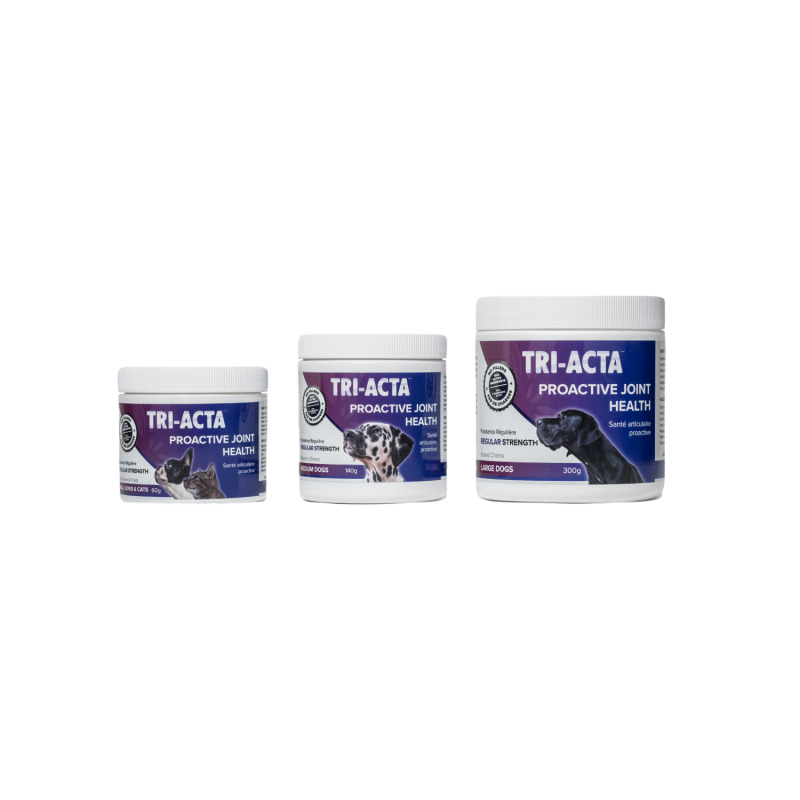
Here is a quick breakdown of what you should be looking for when reading a pet supplement label:
|
What to Look for on a Pet Supplement Label |
Explanation |
|
Active vs inactive ingredients |
|
|
Designations |
|
4. Training and Mental Stimulation
When you get a dog, it’s essential for dog wellness to enroll them in force-free training course so that you can apply the techniques that you learn to help mold good behaviour in your dog throughout their entire life. Force-free training is different from other types of dog training because it focuses on positive reinforcement and doesn’t use methods that startle, scare, intimidate, or cause pain to your dog. With force-free training, you build a bond with your dog, and your dog learns to enjoy training because they are rewarded with kindness, treats, and toys. It also keeps your dog mentally stimulated because they are always learning new things.
Contrary to popular belief, you can actually train your cat! Whether it’s to let you sleep more, allow you to pick them up, or to discourage biting or another behavior, similar principles to force-free training for dogs can be used. Playing with your cat regularly every day is extremely important to encourage good behavior, and ensure that they get the mental stimulation they need to stay healthy and happy. One expert says that one hour of playtime could potentially increase a cat’s lifespan by four hours—making play an important part of cat wellness!
5. Exercise
Training and play sessions count as exercise, but there are other ways you can encourage your pet to move around. Dogs should be taken for regular walks, and dog parks are a great resource to use to allow your pup to socialize with other dogs and burn off energy running around. Cats should be given scratching posts (yes, scratching is good exercise for cats!), a variety of toys, and even cat shelves to encourage them to jump and move around. You can also build or purchase a catio to provide your kitty with some safe outdoor fun.
Importance of Dog and Cat Wellness
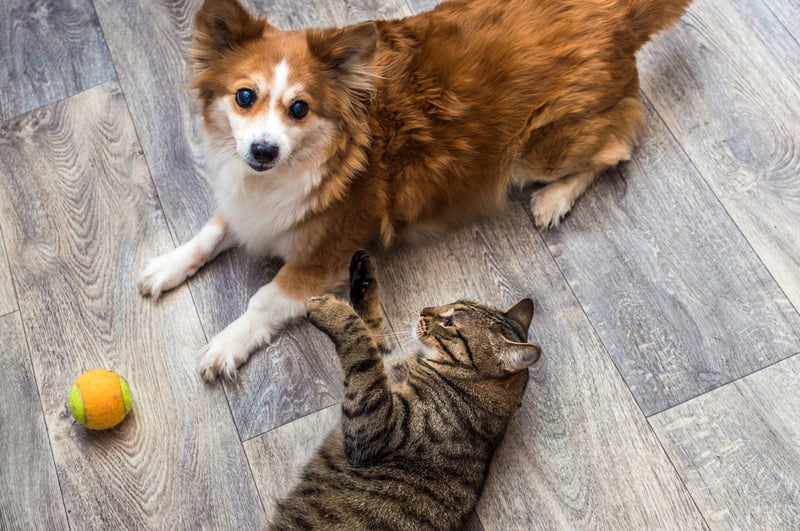
By practicing basic principles of pet wellness, you can help your dog or cat live a fuller, healthier life. By feeding them the right food and making sure they get enough exercise, mental stimulation (play), and of course love, you’re setting your pet up to be the best version of themselves that they can possibly be.
The Importance of Being Proactive
Taking a proactive approach to your pet’s health is not only a great way to help keep them healthy, it’s also a great way to prevent costly vet visits later in life. As we mentioned earlier in this article, degenerative joint disease is a common ailment for dogs and cats. Feeding pet supplements to protect their joints is a preventative measure that you can take to help prevent symptoms.
Dental disease in dogs and cats is another extremely common ailment, and can lead to vet bills in the thousands for dental surgeries and cleanings.
- It’s estimated that over 80% of dogs over the age of three have active dental disease.
- On the other hand, more than half of all cats over the age of three have some form of dental problem.
You can help prevent dental disease in your dog and cat by feeding them high-quality food, and brushing their teeth at least two to three times a week.
Depending on the breed of your cat or dog, there may be other proactive measures that you should be taking. For instance, Persian cats are especially susceptible to cat eye infection because of their brachycephalic (shortened) heads, so giving them cat eye drops and ensuring their eyes and surrounding tissues (fur and eyelids) are clean and free from debris is a good practice. Some dog breeds, like Bulldogs and essentially every large and giant breed dog, are more susceptible to joint issues like dog arthritis, so ensuring that you give them joint supplements is paramount.
Essentially, researching your pet’s breed and knowing their medical history (if you have access to it) is important so that you can make effective decisions about their health and take proactive approaches to ensure that they stay healthy.
Why Are Pet Wellness Exams Vital for Optimal Pet Health?
Taking your dog or cat for regular check-ups at the vet is extremely important, even if they aren’t sick. The main reason for this is that if you can detect a potential problem early, it’s easier to treat and there will be a greater chance of resolution. Plus, if you can catch an issue early, it’ll be less expensive and less traumatic for your pet.
Best Pet Health Food Products
Earlier in this article, we talked about how choosing the best pet health food products for your dog or cat means understanding its nutritional adequacy for the life stage your pet is in, its ingredients, and whether it provides all the nutrients that your pet needs. Based on those factors, we’ve recommended a few different foods. Remember that it’s always a good idea to talk to your vet about any food you choose for your pet, as your pet can have unique nutritional needs.
For Cats
Regarding cat food, there is a heated debate about whether wet or dry food is better. At the end of the day, it really comes down to you and your cat.
- Wet food obviously has a higher moisture content, which can help kitties that don’t like to drink a ton of water or have health issues like reduced kidney function or a predisposition to developing urinary blockages. Wet food is also easier for kittens and senior cats to eat because it’s soft.
- Dry food is easier to store and lasts longer when you set it out for your kitty (doesn’t dry out like wet food). Although it was once thought that dry food is better for your cat’s teeth, it turns out that cats don’t chew their food (they may bite a piece of kibble to break it apart, but won’t “chew” it in the common sense) so there really isn’t a difference between wet and dry in terms of bettering your cat’s dental health.
With those points in mind, here’s a recommendation for one wet food and one dry food:
Best Cat Wet Food: Tiki Cat
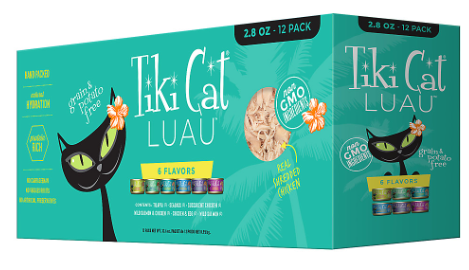
We chose Tiki Cat because it’s a mid-range wet food that offers a great amount of non-vegetable-based protein (16% per can) and is grain and potato-free (grains could cause stomach issues for your kitty). The first three ingredients in this food are all fish or chicken, and although it does have some other stuff like calcium lactate, tricalcium phosphate, and binders (to thicken the “gravy” in the can and keep the shreds together) it offers good value for the cost of the food.
$33.99 CAD for a case of 12 cans. Pricing as of June 2023.
Best Cat Dry Food: Acana
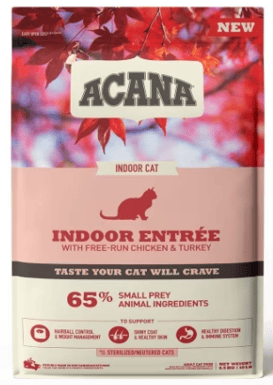
As a Canadian cat food brand, Acana provides high-quality grain-free dry and wet cat food options, but we chose this dry cat food because it’s packed with meat protein, has a good amount of vegetable protein and incorporates antioxidants like blueberries, pumpkin, and butternut squash for good measure. You can even get a fish-only variety if your kitty is allergic to chicken, a common cat allergen.
Starts at $23.99 CAD for a 4lb bag. Pricing as of June 2023.
For Dogs
When it comes to dog food, there doesn’t seem to be as much of a heated debate among dog owners about whether dry or wet is better. However, the same sentiments still apply here: some vets may recommend wet over dry because wet food is easier for the dog to eat, has more moisture content which offers better hydration, and may help with kidney and urinary issues.
That said, here’s a recommendation for one wet dog food and one dry food:
Best Dog Wet Food: Go! Solutions Sensitivities
This limited-ingredient wet food for dogs is perfect for pooches with or without sensitive tummies. It includes one protein source (in this case, cage-free duck), omega oils for skin and coat care, pumpkin for digestion, and antioxidants like cranberries to support your dog’s immune system. One interesting inclusion is taurine, typically found in cat food but has been shown to support vision and heart health in dogs.
$4.99 CAD per can or $59.88 for a pack of 12 cans. Pricing as of June 2023.
Best Dog Dry Food: Nutrience® Grain Free SubZero Dog Food

We chose Nutrience because it delivers the same nutritional content as a raw food diet for dogs but in a more convenient, dry-food package. This is partly due to the inclusion of fresh wild-caught fish and real freeze-dried fish pieces. It’s Canadian-made, and includes pumpkin to aid digestion, blueberries and other fruits for antioxidants, and a plethora of vitamins and minerals.
Starts at 29.74 for a 5lb bag. Pricing as of June 2023.
Best Pet Wellness Products
Aside from providing your pet with healthy, high-quality food, you can also give them various other pet wellness products. Here are some suggestions:
1. Joint Supplements
It’s estimated that as many as 20% of dogs in North America (1 in 5) and 40–90% of cats (4–9 for every 10 cats) will experience degenerative joint disease. Since many cats and dogs end up with joint issues, giving them a joint supplement every day can help prevent their joints from degeneration, or at least help them better cope with the symptoms.
TRI-ACTA is a great option for a preventative joint supplement for dogs and cats of all ages and sizes. Combining two types of glucosamine and chondroitin helps prevent cartilage degradation and aid in its repair and support joint tissues and muscles. Methylsulfonylmethane (MSM) is a natural anti-inflammatory that helps your pet with joint pain. If your pet is a senior or has a chronic joint condition, TRI-ACTA H.A. is recommended. It includes all of the ingredients of our regular-strength version but has hyaluronic acid, which further helps with joint mobility.
TRI-ACTA H.A. for Pets
Our maximum strength formula is optimally designed to accelerate the formation of cartilage, minimize inflammation, expedite the healing process, and improve joint conditions.
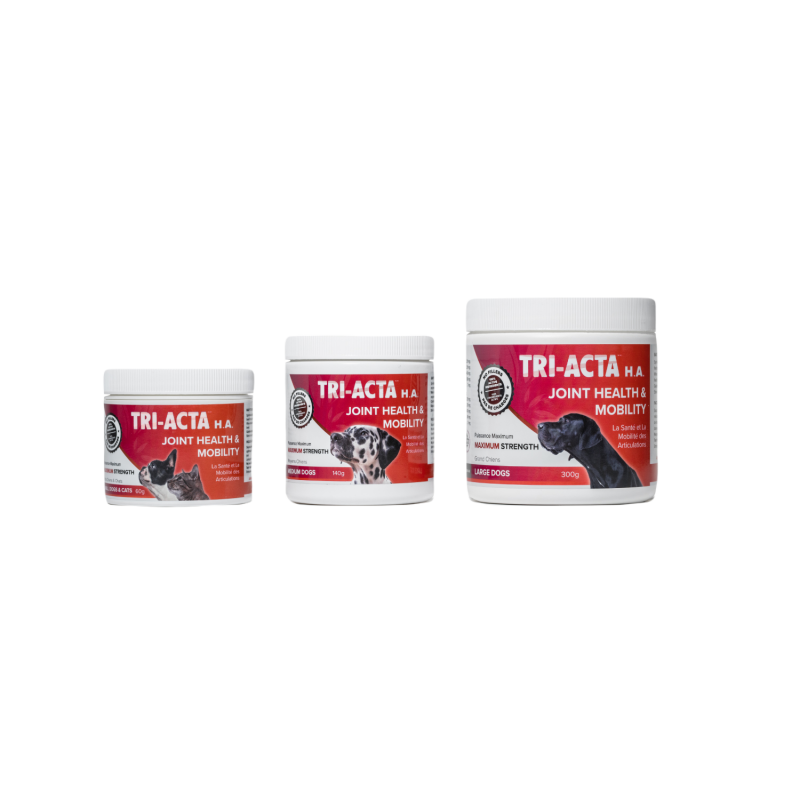
2. Probiotics and Prebiotics
Probiotics are undigestible fibers that feed the good bacteria in your pet’s gut, while probiotics are the friendly bacteria. Combining these two in a supplement can help your pet with digestion, prevent potential tummy troubles, or restore the healthy gut bacteria that may have been lost due to vomiting or diarrhea.
3. Calming Treats
Sometimes our furry friends get anxious or scared, for example, when they are travelling with us or there’s a thunderstorm outside. Giving them a calming treat, which usually contains sleepy ingredients like melatonin, tryptophan (often found in turkey), and theanine (found in plants and fungus) helps your pet relax so that they can get through whatever anxious or scary situation they are in easier. Of course, cuddles help too!
Ready for the Unexpected: Creating a Pet Wellness Plan

Taking care of a pet can be expensive, especially if you have a purebred animal. Purebred dogs, for example, have a higher chance of developing cancer and genetic disorders. However, joint disorders seem just as common in mutts as in purebred dogs. When it comes to cats, purebreds are much more rare—the vast majority of cats are simply domestic shorthair or longhair and don’t have a specific breed. If you get a purebred cat, they can suffer problems like dental disease, overgrown nails, eye discharge, coat (fur) disorders, polycystic kidney disease, and more. Of course, non-purebred cats can suffer from these issues as well, they are just more prevalent in purebred cats.
With the number of diseases and disorders that can potentially ail your pet, one of the ways you can be proactive about their care is to purchase a pet wellness plan. These insurance policies help you pay for costly procedures, medications, vet visits, and a host of other things that you need to keep your furry friend happy and healthy.
It’s important to note that pet wellness plans differ from insurance; they are meant to cover regular preventative pet health costs you know your pet will need, while insurance is meant to cover unexpected injuries or illnesses.
Here is a quick breakdown of what a typical pet wellness plan may cover versus a pet insurance plan:
|
Pet Wellness Plan |
Pet Insurance Plan |
|
|
|
|
By purchasing a pet wellness plan alongside insurance, you can save money on common procedures while at the same time be prepared for unexpected situations.
Summary
The best way to practice good pet wellness is by educating yourself on the best pet wellness techniques and best practices to keep your dog or cat healthy throughout their lifetime. Giving your pet supplements and high-quality pet food and being sure to purchase a pet wellness plan as well as insurance helps reduce vet visit costs and ensures you’re prepared if anything goes wrong (like an unexpected injury or illness)
One of the best preventative measures you can take to ensure general pet wellness is giving your pet joint supplements. TRI-ACTA products contain 100% natural ingredients, are approved by Health Canada as veterinary health products, and are easy to administer.
Purchase TRI-ACTA online today or learn where to buy.
TRI-ACTA H.A. for Pets
Our maximum strength formula is optimally designed to accelerate the formation of cartilage, minimize inflammation, expedite the healing process, and improve joint conditions.

Newsletter Signup
Subscribe to our newsletter to receive the latest news and exclusive offers.
.jpg?height=2000&name=Cliick_Integricare-DISPLAY-REVISEDV2%20(1).jpg)
Proactive & Therapeutic Joint Supplements
When given daily, Integricare joint supplements recover bone and joint injuries faster and help prevent mobility injuries from happening in the first place.

